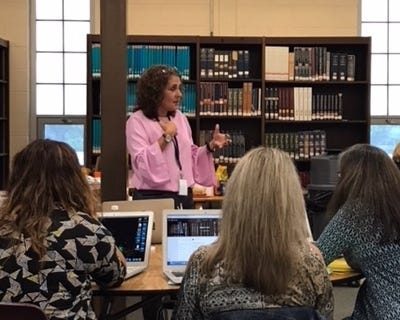A Q&A with a District Curriculum Supervisor
Jayne VanNosdall is the Curriculum Supervisor of English (6–12) for Brick Township Public Schools in New Jersey. For this Q&A, Jayne spoke with CommonLit’s Director of School Partnerships, Rob Fleisher. Jayne explains how her team utilized CommonLit’s Interim Assessments and student analytics to increase rigor and alignment to state standards, ultimately improving reading outcomes for students.
“The average class grew by an average of 13.8 percentage points on informational texts and by 14.5 percentage points on literary texts.”
Rob: How has your team decided to implement CommonLit this school year?
Jayne: Before this school year, our teachers were using CommonLit intermittently, but this year we decided to adopt CommonLit’s data and benchmark assessment package for districts. In recent years, we found that our test scores didn’t meet our expectations and that we weren’t seeing the student growth that we wanted, despite changes in curriculum and practice. I felt that our instructional resources were not aligned to the skills and standards that students needed to master in order to succeed on the PARCC assessment (New Jersey’s state assessment).

In New Jersey, teachers also have Student Growth Objectives (SGOs). SGOs are meant to ensure that students are making measurable growth. However, in the past, our department didn’t have a rigorous or unified way of measuring progress. Teachers would often use a final exam or a previous marking period grade as baseline data, but these weren’t equitable or accurate measures. So, I discussed with my teachers the concept of a benchmark assessment that would be much more tightly aligned to standards-driven instruction.
So, that’s when I started talking to you about how we can build benchmark assessments that could more clearly and accurately measure students’ progress throughout the course of a semester.
Rob: You mentioned that you thought something was missing from instruction. Can you explain how CommonLit has changed teachers’ instruction this year?
Jayne: At the high school level, many teachers enjoy teaching novels — and it’s the reason that many of us became English teachers — but CommonLit has given our students a chance for more standards-based practice with the kinds of questions that they’ll see on their state assessments. The teachers I work with are passionate about their craft, but my team isn’t necessarily trained in creating solid test questions. Oftentimes when teachers try to create questions, they create ones that they know the answers to or that can be found in the text without much critical thinking. We need to move away from rote questions. So, CommonLit provided that common platform for all of the students to get the practice they needed to be successful with more rigorous questions.
Rob: What work did you do with CommonLit before the beginning of the school year to create benchmark assessments?
Jayne: Before the beginning of the school year, I had the chance to look at the state assessment results from the last school year. I dug into the data and identified the standards where our students struggled the most. You and I talked about customizing two assessments — one that students would take at the beginning of the semester and one at the end of the semester. Without this mechanism in place, we’d never be able to know if students were actually making progress throughout the year or if teachers were working with students on the skills that they needed to build to improve their performance on those standards. This benchmark guarantees that students are getting practice and exposure on the standards that they are weakest in.

A few weeks ago, we finished our first semester and we got to go back and analyze how much students grew throughout the semester on our priority standards. The average class grew by an average of 13.8 percentage points on informational texts and by 14.5 percentage points on literary texts. I’m excited to see the results from the most recent administration of PARCC. Based on these numbers, we’re thinking that we’ll see a big improvement in those scores.
Another powerful resource is the administrator dashboard. There, I can continuously see how much growth students are making on each standard. This allows me to accurately track in real time if students are making progress toward a particular standard or set of standards.

Rob: Can you describe what it’s been like working with the CommonLit team this school year?
Jayne: The staff at CommonLit has been great. You have been so attentive to our needs; our teachers have reached out to you during the school day with questions and almost immediately have received a reply. My department is most impressed with your prompt communication. You’ve helped me break down the data. Your team also led a great webinar on the first day of school that set all of the teachers up for success.
Overall, CommonLit is a robust program with so many offerings that are aligned nicely to any English curriculum. It provides outstanding supplemental reading, corresponding questions, and writing opportunities. It’s built with an English teacher in mind.
Bring CommonLit to your District
Click here to learn more about CommonLits District Solutions. To connect directly with me or another member of our School Partnerships Team, send an email to Partnerships@CommonLit.org.


